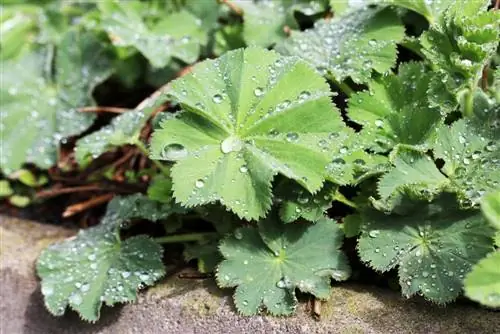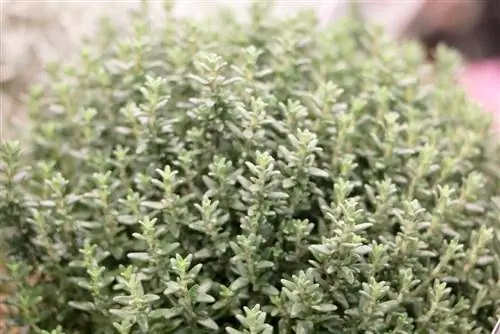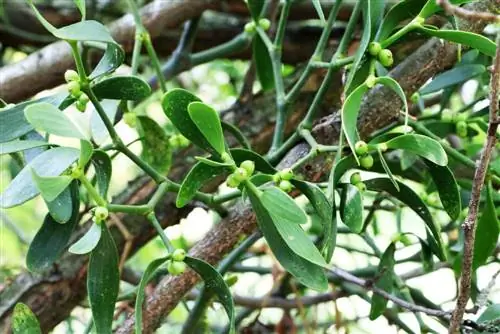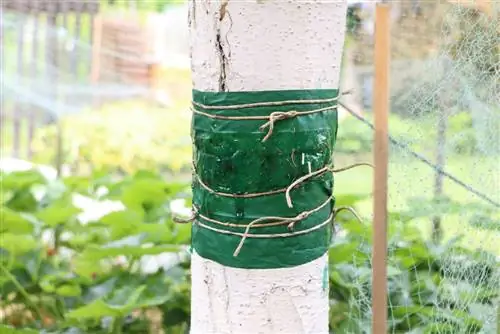- Author admin [email protected].
- Public 2023-12-17 03:39.
- Last modified 2025-01-24 12:45.
Lady's mantle is a rather inconspicuous plant. But people already knew about its hidden healing powers in ancient times. To date, it is still valued as a natural remedy for numerous he alth problems. It also has beneficial effects as a tea. A handful of leaves is all that is needed. This is how you harvest and dry lady's mantle that grows wild or blooms in the garden.
Ladies mantle and its names
If the lady's mantle plant doesn't mean anything to you, it can still be a familiar friend. This is supported by the fact that it is extremely widespread. The only unknown thing might be the name Lady's Mantle. He is not known by this name everywhere. Do you perhaps know this medicinal plant by one of the following names?
- Goosefoot
- Alchemist Herb
- Silberkraut
- Beautiful with tears
- Christmascoats
And those aren't all the well-known names! The lady's mantle has around 70 popular names. There is only one botanical name for the common lady's mantle: Alchemilla vulgaris.
Appearance and growth
The lady's mantle grows upright but low. Its leaves are kidney-shaped to rounded and lobed. Large, round drops of water form on it every day. The flower is yellow-green and has the shape of a panicle. It appears from June to July and reblooms in September.
This is how lady's mantle works
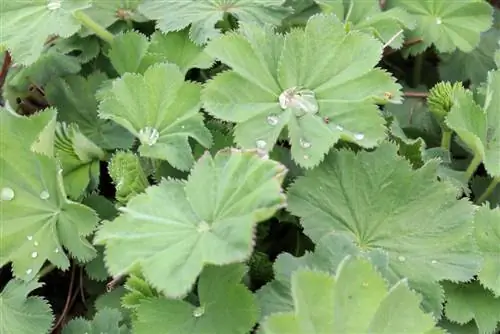
The lady's mantle impresses with a whole range of good active ingredients. Here is an excerpt: bitter substances, tannins, glycosides, saponins and phytosterols. Depending on the application and symptoms, they can work as follows:
- antibacterial
- calming
- blood purifying
- promotes blood circulation
- anti-inflammatory
- antispasmodic
- pain relieving
- digestive
The areas of application
The lady's mantle also contains, among other things, a plant substance that is very similar to the hormone progesterone. This is the main reason why lady's mantle plays such an important role in gynecology. It particularly helps with:
- Period pain
- Menopausal symptoms
- Preparing for birth
But men also benefit from its active ingredients, because the silver herb alleviates numerous other complaints:
- Stomach problems
- Colds
- Headache
- Insomnia
- Kidney weakness and much more m
These are all good reasons to expand your own tea collection to include lady's mantle tea. Of course, lady's mantle can also be used in other dosage forms.
Where can you find the lady's mantle?
Lady's mantle often grows in your own garden. If you don't yet have your own goosefoot but are impressed by its healing powers, you can plant a new plant in your garden at any time. Under optimal conditions, their growth takes off rapidly. However, there are also wild-growing varieties whose exact location has yet to be discovered. You might find what you're looking for in the following places:
- can be found from the lowlands to the Alps
- at the edges of forests
- on pastures and lush meadows
- in sparse bushes
- in other moist and nutrient-rich locations
Which parts of the plant are suitable for tea?
Leaves and roots of the plant are suitable for lady's mantle tea. However, since picking the leaves is convenient and does not cause much damage to the plant, this should be the preferred method. Fresh leaves are ideal for making tea. If possible, they should be harvested shortly before brewing. If fresh leaves aren't available, it's nice to have a dry supply.
Optimal harvest time
The harvest season extends to its prime. This is always from May to August. If the lady's mantle is easily accessible, it should initially only be harvested fresh for current needs. Only in August should enough leaves be picked and dried as tea for the cold season.
- Collect May to August
- a rain-free morning is ideal
- after two previous sunny days
- then the content of aroma and active ingredients is highest
Tip:
If you have completely used up your dried lady's mantle tea, you can also harvest some fresh lady's mantle leaves in the spring.
How to harvest
All you need to harvest is a sharp knife to cut through the stems cleanly. And of course a basket or bag to collect the leaves in.
- wait until the dew has dried
- Picking leaves with stems
- Roots are dug up in autumn
Tip:
Do you have the choice between a wild lady's mantle and a garden specimen? The decision is simple: the higher active ingredient content speaks for the wild-growing plant.
Make your own dry tea

From September to April, which is the longer period of time, the plant no longer provides green supplies. Therefore, a larger quantity of leaves must be harvested in good time and preserved for winter tea by drying.
- dry only freshly picked leaves
- Do not wash the leaves to preserve the aroma
- clean the dust by shaking it out
- wash only if absolutely necessary
- then pat dry with kitchen paper
- dry only whole and undamaged leaves
Air drying tea leaves
This method is quite simple and yet delivers the highest content of active ingredients in the end result. If the focus is not on the taste of the tea, but rather on its healing properties, this drying method is primarily recommended.
- Tie leaves into a bundle with yarn
- Hang upside down to dry
- Suitable place is warm, shady and protected from wind
- do not expose to direct sunlight
- Dry rooms and attics are optimal
- Duration depends on the temperature
- Drying may take several days
Note:
Caution is advised in attics as they can heat up significantly in summer. The room temperature must not exceed 35 degrees Celsius so that the essential oils are not destroyed.
Lady's mantle dry in the oven
Some of the ingredients are lost in the oven. However, if no other drying option can be used, the oven is a good alternative. Especially when the healing ingredients are not the main reason for making tea.
- set lowest degree
- increase after half the time
- but not higher than 50 degrees Celsius
- Leave the oven door ajar
- Dry the leaves for about 3 hours
Drying in a dehydrator
A good dehydrator dries the leaves gently and thus preserves most of the valuable ingredients. If you don't own a dehydrator yet, you can buy one cheaply in stores. It can also be used for many other herbs and fruits.
- follow the manufacturer's instructions for use
- Set temperature up to max. 50 degrees Celsius
Storage and shelf life
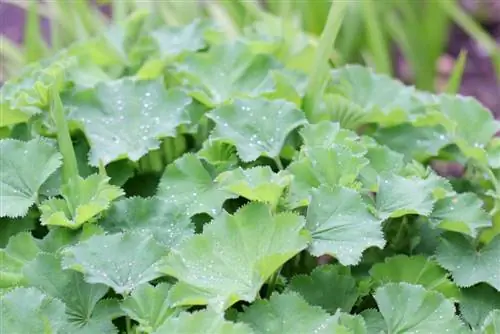
After drying, the whole leaves are chopped up and stored in an airtight container or jar. A dark and cool storage location is optimal. Dry lady's mantle tea has a shelf life of at least one year. Since the fresh leaves can be harvested every year, this period is completely sufficient to have a continuous supply of lady's mantle tea.
Preparing lady's mantle tea
Some things that are supposed to heal come with an inedible taste. It is only taken because it is supposed to help with the unbearable symptoms. Things are different with lady's mantle tea. Tea connoisseurs describe it as extremely aromatic. How to make a cup:
- Cut or crush a handful of fresh leaves. The amount should fill 2-3 teaspoons. Alternatively, use about two grams of dried tea.
- Put the crushed leaves in a tea filter.
- Pour 250 ml of boiling water over it.
- Let the tea steep for about 10 to 15 minutes.
Up to five cups of lady's mantle tea, spread throughout the day, are permitted.
Tip:
Didn't spot a lady's mantle plant nearby? Didn't find time to collect? No problem, no one has to go without its healing effects. You can get lady's mantle tea loose or as tea bags in drugstores, pharmacies and well-stocked supermarkets.

